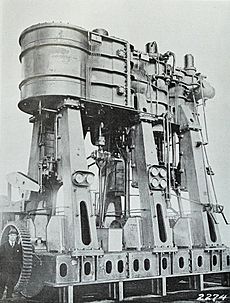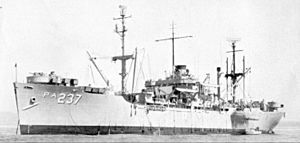Joshua Hendy Iron Works facts for kids
 |
|
| Industry | Engineering & Manufacturing |
|---|---|
| Successor | Westinghouse Electronic Systems |
| Founded | 1856 |
| Founder | Joshua Hendy |
| Defunct | 1947 |
| Headquarters | , |
| Products | Mining equipment, marine engines etc. |
|
Number of employees
|
60 (1940); 11,500 (1945) |
The Joshua Hendy Iron Works was an American engineering and manufacturing company. It started in the 1850s and operated until the late 1940s. For a time, it was a world leader in making mining tools. Its equipment helped build big projects like the Panama Canal. The company worked in many different areas over the years. Today, it is best known for its important role in the American shipbuilding industry during World War II.
Contents
How It All Began
The company was named after its founder, Joshua Hendy. He was born in Cornwall, England in 1822. When he was 13, Hendy moved to the United States with his two brothers. He later became a blacksmith in Houston, Texas. After facing personal challenges, he sailed to San Francisco in 1849. He hoped to find success during the California Gold Rush.
Hendy built California's first redwood lumber mill. This mill was called the Benicia Sawmill. The area where it stood is now known as the Hendy Woods State Park. In 1856, he started the Joshua Hendy Iron Works in San Francisco. His goal was to provide tools and machines for the Gold Rush miners. The Hendy factory supplied many different kinds of equipment to the mining industry.
A Leader in Mining Tools
By the 1890s, the Joshua Hendy Iron Works was a top company in the mining world. It sent equipment to mining companies all over the globe. This equipment included ore carts, ore crushers, and stamp and ball mills.
Many of the clever designs Hendy created became standard for the mining industry. These designs were still used as late as the 1970s. Some examples include the hydraulic giant monitor and the Hendy ore concentrator. Hendy's huge hydraulic crushers were even used to dig out the Panama Canal.
Joshua Hendy passed away in 1891. His nephews, Samuel and John, took over the company. In 1906, a fire destroyed the original San Francisco factory. The company then moved to Sunnyvale, California. The local government helped them by offering free land.
Helping in World War I

During World War I, the Hendy factory started building marine engines. They supplied 11 large triple expansion steam engines for cargo ships. These ships were built by Western Pipe & Steel for the U.S. Shipping Board. Each engine was very heavy, weighing about 137 tons, and stood 24½ feet tall.
Even though these were the first marine engines Hendy built, they worked very well. Most of them lasted for many years. The company used almost the same engine design, with small improvements, to mass-produce engines for US Liberty ships in World War II.
Between the World Wars
In the early 1920s, Hendy's hydraulic mining equipment was used in a huge project. This project was the regrading of Seattle. It was one of the biggest changes ever made to a city's landscape.
However, when the Great Depression began, the Hendy Iron Works faced tough times. Like many other heavy equipment makers, the company struggled. It found new ways to stay in business by taking on different projects. For example, they built giant gates and valves for hydroelectric projects. These included the Hoover and Grand Coulee dams.
During this period, Hendy also made many other things. They produced crawler tractors, parts for internal combustion engines, and even standards for street lamps. Some of the fancy street lamps they built can still be seen in San Francisco's Chinatown today.
Major Role in World War II
By the late 1930s, the company was in financial trouble. It had become much smaller, with only 60 workers in 1940. The Bank of California was taking over the company. But then, a businessman named Charles E. Moore stepped in. With support from the Six Companies, he took control.
Moore quickly got a contract with the US Navy to build torpedo tube mounts. Soon after, he secured a contract for twelve triple expansion marine steam engines.

By 1942, the US government's wartime Emergency Shipbuilding Program was in full swing. It was clear that many new marine engines were needed for the ships. Since there weren't enough modern steam turbines, most new Liberty ships would need older, slower reciprocating steam engines.
Admiral Vickery asked Moore if he could double the original order of 12 engines. Moore reportedly said it would be just as easy to prepare for a hundred as for a dozen. The company then received a contract to build 118 triple expansion steam engines for the Liberty ships.
As the war continued, the shipbuilding program grew. Orders for new engines also increased. Moore made production at the Joshua Hendy plant more efficient. He used advanced assembly line methods. This meant more parts were standardized, and less skilled workers could do tasks that once needed skilled machinists. By 1943, the company had cut the time to make a marine steam engine from 4,500 hours to 1,800 hours. The number of workers also grew a lot, reaching 11,500 during the war.
By the end of the war, the Joshua Hendy Iron Works had supplied engines for 754 of America's 2,751 Liberty ships. This was about 28% of all Liberty ship engines, more than any other factory in the country. Later in the war, the company also made 53 steam turbines and reduction gears for the faster, more modern Victory ships.
After the War
In 1947, the Joshua Hendy Iron Works was sold to the Westinghouse Corporation. After the war, the factory kept making military equipment. This included missile launching and control systems for nuclear-powered submarines. They also made anti-aircraft guns.
The plant also produced pressure hulls for underwater vehicles and equipment for nuclear power plants. Other products included huge wind tunnel compressors, large radio telescopes, diesel engines, and electrical equipment.
In 1996, Westinghouse sold the plant to Northrop Grumman. It was then renamed Northrop Grumman Marine Systems.
Images for kids




